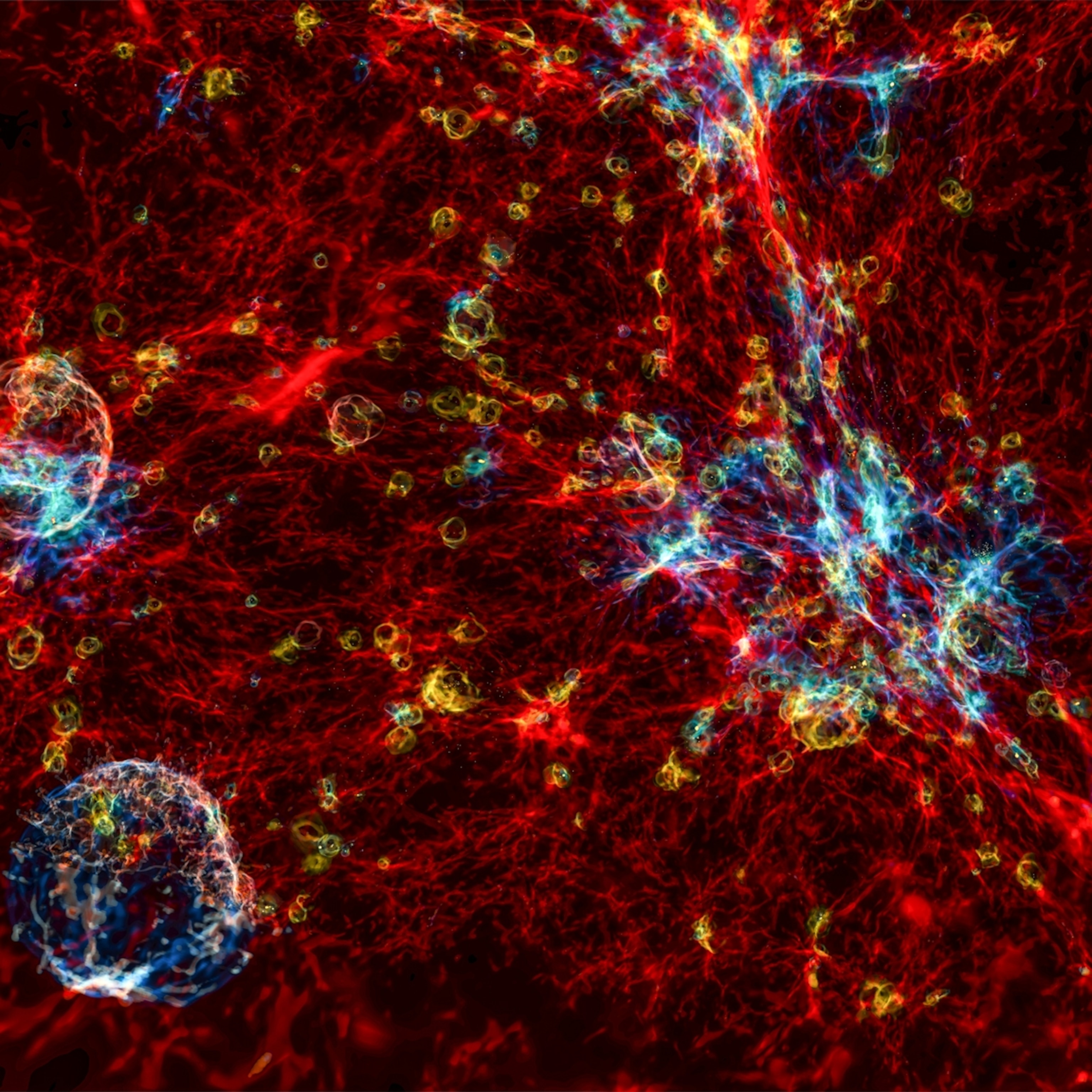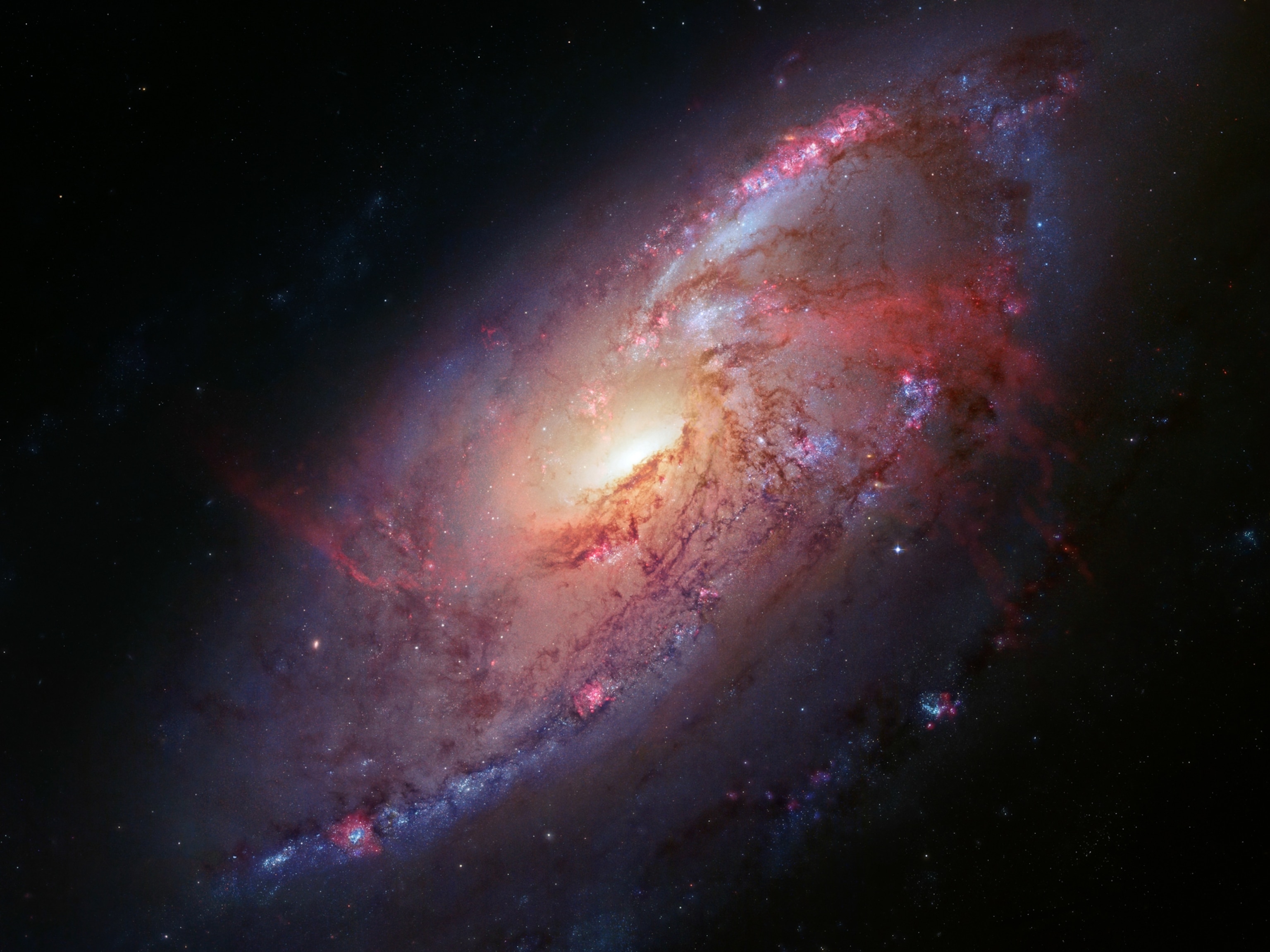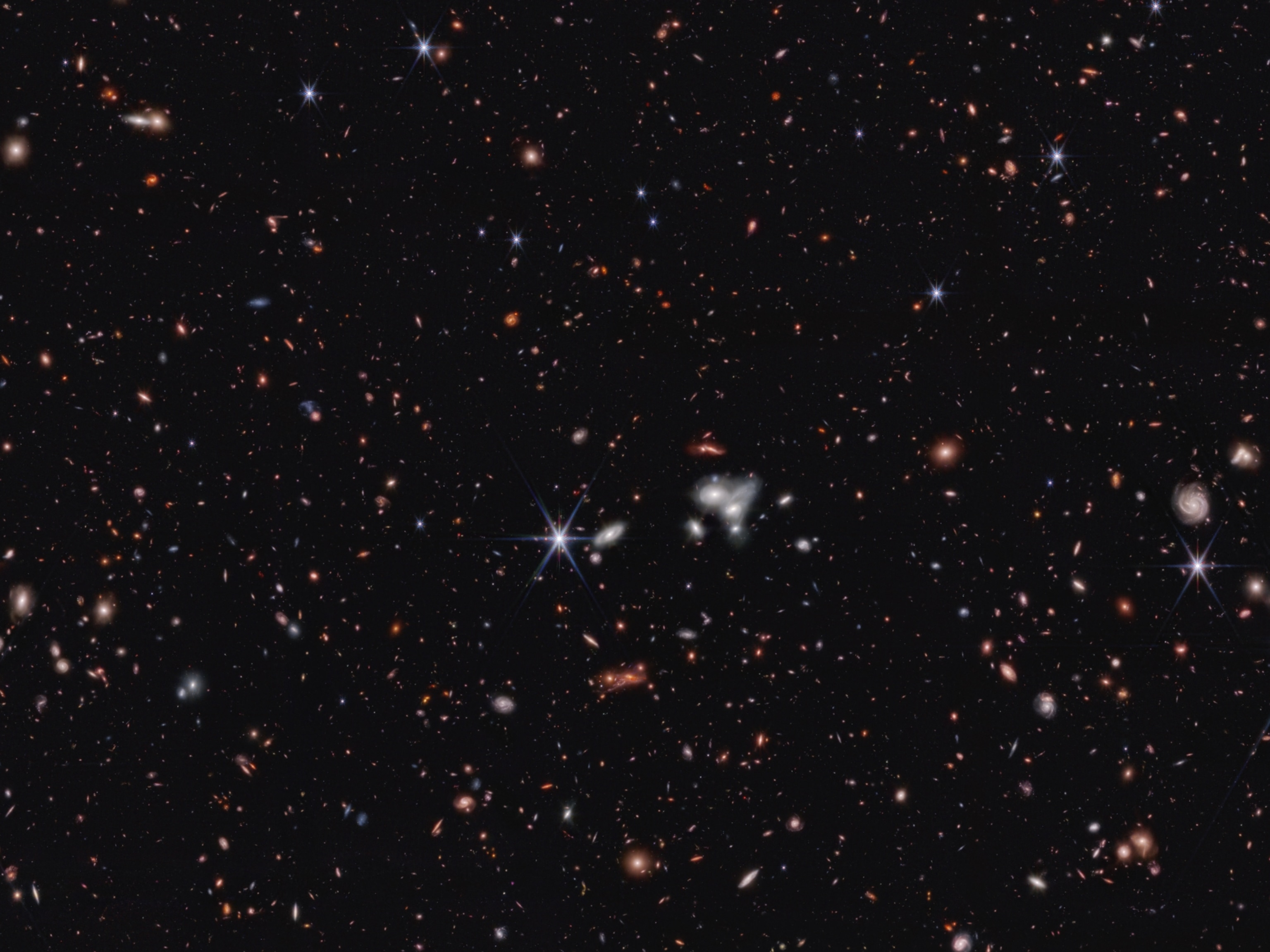
For the world’s most advanced space telescope, and the thousands of people who’ve worked on it over the decades, the starting gun has fired.
After more than a quarter-century of planning, designing, building, waiting—and of obsessively testing the most complex space observatory ever assembled—the mammoth James Webb Space Telescope finally launched at 7:20 a.m. eastern time on December 25.
Whether that flaming rocket ride represents a year-end gift to science or a catastrophic conclusion to 2021 depends on the weeks ahead. For JWST’s mission to succeed, the telescope must execute an intricate series of carefully choreographed maneuvers during its first month in space. Even a single misstep could compromise the entire mission. And the telescope must perform its devilishly difficult dance far beyond the reach of human hands, hurtling toward a point in space a million miles away.
“This is a high-risk and a very high-payoff program,” NASA deputy administrator Pam Melroy said during a call with reporters on December 21. “There are a lot of hard, long weeks ahead, where the telescope has to deploy perfectly.”
But the risk is worth the reward. When JWST opens its golden, 21-foot-wide eye, it will transform our view of the cosmos and of ourselves. The telescope's mission is to tell the story of the universe, from a few beats after its radiant, percussive birth through the sweep of cosmic ages until now—when humans craft machines that are powerful enough to look back to the beginnings of space and time.
With an eye that’s sensitive enough to see a bumblebee in lunar orbit, the telescope will peer into the primordial murk from which stars, galaxies, and planets emerged, piercing the darkness that has occluded the gaze of other great observatories.
“Don’t think about JWST as a space telescope—it is a space-time telescope,” says Mark McCaughrean, senior science advisor at the European Space Agency (ESA). “It’s doing time travel at the same time it’s examining space. We’re looking back through the universe, close to the edge of the big bang 13.8 billion years ago.”
The telescope’s final stop on Earth was the Guiana Space Centre in Kourou, French Guiana—an expansive launch complex that’s bordered on one side by the tangled Amazonian jungle and on the other by the Atlantic Ocean. NASA is responsible for the bulk of the mission’s $10 billion bill, but ESA, one of several partners, provided the Ariane 5 rocket needed to ferry the telescope into space from the leafy tropical outpost.


Like many of humankind’s most ambitious projects, JWST has hit multiple snags on its path to space. The telescope is massively over budget and is launching more than a decade late—partly a consequence of unrealistic early plans. But as many astronomers point out, even the beloved Hubble Space Telescope faced similar woes.
“Hubble was worth it, and Hubble was late. Hubble was broken! And Hubble changed the planet,” says astronomer John O’Meara, chief scientist at the Keck Observatory, who’s already working on the design for Webb’s successor. “A lot of the people who are unhappy about Webb today are going to forget their unhappiness when the first deep field image shows up and they get their socks blown off."
Some of the delays to JWST are the result of mistakes made while building the observatory, including using the wrong solvent on its propulsion valves and shaking several screws loose during testing. More recently, the telescope’s name has provoked controversy among astronomers who are concerned that James Webb, NASA administrator during most of the 1960s, may have been complicit in implementing homophobic policies at the agency—a claim that NASA says is so far unsubstantiated.
In the month leading up to launch, the telescope suffered another mishap when a crucial clamp unexpectedly released, sending tremors through the observatory. Then a communications issue between the telescope and the ground systems at the launch complex delayed the mission by several more days. The final delay was a result of inclement weather in French Guiana—where the rainy season rolled in to keep the telescope grounded until Christmas Day.

JWST’s rocket ride is just one fiery step in its journey, and the anxiety is likely to ratchet even higher in the weeks after launch as astronomers wait for JWST to complete its tricky unfolding sequence and reach its final position in space.
“It’s going to fricking suck if it doesn’t deploy right,” O’Meara says. But, he adds, even a failure wouldn’t be the end of astronomers’ ambitions.
“I believe very firmly that the story Webb is telling, as part of a continuum of missions, is so compelling that we won’t stop trying to tell it,” O’Meara says. “The universe is telling us really, really exciting things right now, and there’s no way we’re going to give up on those things.”
Unfurling a golden eye in the sky
JWST’s risky design is a consequence of the mission’s audacious goals: To see so deeply into the cosmos, the enormous telescope needs to be light enough to make the million-mile journey, and it needs to be chilled to extremely low temperatures once it gets there.
“Designing a huge telescope that has to operate in space and be cold was, and is, an extremely challenging engineering scenario, and that drove all of the engineering design,” NASA astrophysicist Amber Straughn said during a recent news conference.

At six tons, JWST is half the mass of the Hubble Space Telescope despite having a primary mirror that’s more than twice as large. Engineers built that mirror out of beryllium, a relatively rare metal that’s lighter than aluminum but stronger than steel. They sculpted, smoothed, and pressed the metal into 18 hexagonal segments, and then dusted the honeycomb mirror with gold to help it reflect as much infrared light as possible.
The telescope’s four primary science instruments will look for longer, redder wavelengths of light than Hubble can see—light that has been stretched into the infrared as it traveled across the ever-expanding universe. Ambient radiation from the telescope itself, and from nearby objects, can mask that precious light unless JWST’s instruments are kept extremely cold. Perhaps surprisingly, though, anywhere near Earth’s orbit, space is relatively warm. So the telescope is carrying a gigantic five-layered sunshield made of a shiny, translucent material called Kapton.
JWST will deploy its sunshield during the first week after launching, and once it arrives at its destination, the telescope will be able to shield itself from the heat and glare of the sun and Earth. Then, the side of the observatory facing into the dark of space will cool to minus 388 degrees Fahrenheit (40 Kelvin).
The trouble is, packing all of that material into a rocket fairing—even one as large as the Ariane 5’s—doesn’t work unless the observatory is folded up.
Once in space, it will begin stretching out and unfurling all those parts—first the solar arrays and communications hardware, then the sunshield, a small secondary mirror, and finally the honeycombed eye. In all, there are 344 single points of failure to get through in the 29 days after launch, most of which come from the multi-layered sunshield.
Engineers have tested the hardware again and again, but clean rooms on Earth don’t truly simulate the ordeal of being violently expelled from Earth’s orbit and flung into the gravity-free realm of deep space.
“Honestly I would say there’s a lot of trepidation and nervousness, knowing the things that can go wrong, some of which we’ve prepared for,” says JWST’s deputy telescope scientist Marshall Perrin of the Space Telescope Science Institute (STScI), which will take control of the telescope about half an hour after launch. “But there’s always the unknown unknowns. There’s a lot of nervousness for everything in that 29 days on the edge.”
A new window to the cosmos
JWST’s mission, writ large, is to help tell the story of the universe—how the maelstrom of particles, elements, and molecules that populate the universe somehow combined to produce stars and galaxies and, ultimately, this inhabited world.
“We want to know: How did we get here from the big bang? How did that work?” says John Mather, JWST’s senior project scientist. “How is it possible for humans to have what we have here on little Earth?”
To tell that story, scientists need to go back to the very beginning. But the infant universe is a miasma of chaos and radiation shrouded in darkness. We don’t really know how, or exactly when, the lights turned on—how stars began shining amidst a sea of hydrogen and helium created when the cosmos exploded into existence some 13.8 billion years ago. We don’t know how or when the first galaxies formed, or what they looked like.

As it peers back toward the earliest beginnings of time, JWST will spot the signatures of those primitive stars and galaxies—likely seen as small specks in the expanse, but crucial for understanding how the cosmos grew up. Those observations will mark the first time scientists get a look at the shapes and compositions of the most ancient structures of the universe.
We also don’t know how the first bottomless pits of space-time we now call black holes formed, or how some managed to quickly pack a billion suns’ worth of material into a tiny pocket of space. “It’s really challenging to make these very massive black holes early in the universe,” says NASA’s Jane Rigby, operations project scientist for JWST.
In addition to making images, JWST studies the cosmos by gathering light and splitting it into its components, like a prism dividing sunlight into a splash of rainbow colors. In those spectra, scientists can see the signatures of different molecules, atoms, and gases—things like hydrogen, nitrogen, water vapor, ammonia, methane, and carbon dioxide. Scientists will know which galaxies came first because of their elemental signatures and the ways in which their light has been stretched as it flies across the cosmos.
“Spectra is what tells us what objects are made of. Images are beautiful, they are spectacular, they tell us the morphology, what the objects look like, but astronomers want to know the composition,” ESA’s Antonella Nota told reporters in November. “While an image is worth a thousand words, spectra are worth a thousand images.”
JWST will also look closer to home. The observatory will study more mature galaxies to learn how these cosmic structures evolve over time, and it will stare through the atmospheres of planets orbiting other stars within our own Milky Way—alien worlds that could be the key to understanding how planets are put together, how they grow and evolve, and how some of them could become habitable. The telescope will even study worlds within our own solar system, such as Mars and the icy moons of Jupiter and Saturn that scientists believe could harbor life today.
“Our science case literally spans the whole observable universe,” Rigby says.
Peering farther than ever before
O’Meara, who helped decide which observations the telescope will make in its first year of operations, says he’s optimistic that the mission will be transformational. “I think half the science Webb will be doing when its mission ends is not anything we know about today,” he says.
That’s been true each time humankind has looked at the cosmos through new eyes. In 1989, when astronomers first started talking about an infrared successor to the Hubble Space Telescope, they had only a partial sense of what the instrument would eventually be asked to do. At the time, some of JWST’s most intriguing otherworldly targets had yet to be discovered.
“We didn’t design it for exoplanets at all,” McCaughrean says. “They didn’t exist.”
Astronomers found the first planets orbiting faraway stars in the 1990s, and since then, planet hunters have revealed that the Milky Way is populated by countless alien worlds. Now those faraway worlds comprise roughly a quarter of the mission’s early targets. But an even bigger surprise was in store.
In 1995 astronomer Bob Williams performed what would turn out to be a legendary experiment. As STScI director, he had a certain amount of Hubble observing time to do with as he pleased. And Williams wanted to point the telescope at an empty patch of sky, roughly the size of a thumbnail, for over a hundred hours to see what turned up.
It wasn’t exactly a popular idea. “He had good reason for it, although some people were seriously against it,” Mather says.
It seemed to many like a waste of time—after all, nothing appeared to be there. But when those hundred hours were up, Williams and his colleagues had produced an astounding image, now called the Hubble Deep Field. Thousands of distant, ancient galaxies dappled that deceptively vacant patch of sky, sparkling like multicolored jewels strewn across black velvet. Hubble had peered across space and time and demonstrated that the cosmos is positively stuffed with galaxies—and many of the most distant galaxies Hubble could see were larger and more developed than scientists had expected.
As soon as that image emerged, Mather says, astronomers demanded that JWST do the same thing, looking even farther away and further back in time.
“The deep field was so beautiful and so challenging and so unlike what people had expected,” Mather says. It made astronomers think “wow, gotta pursue that.”
Some of the observations JWST will make are similar to the Hubble Deep Field. In a small patch of sky, Rigby says, thousands of galaxies that were too faint for Hubble to see will pop out of the darkness.
Like so many missions before it, JWST has the potential to discover something so profoundly unexpected that it will revolutionize how we think about our place in the cosmos. Each time scientists look at the universe with bigger, sharper eyes, they see a still more glorious dawn.
“The universe,” Mather says, “is going to be more complicated than you’ve ever imagined.”
Editor’s Note: This story has been updated to reflect the successful launch of the James Webb Space Telescope.
Editor's Note: This story has been updated to remove a quote about the beryllium mirrors. The spelling of Antonella Nota's name has also been corrected.
You May Also Like
Go Further
Animals
- When did bioluminescence evolve? It’s older than we thought.When did bioluminescence evolve? It’s older than we thought.
- Soy, skim … spider. Are any of these technically milk?Soy, skim … spider. Are any of these technically milk?
- This pristine piece of the Amazon shows nature’s resilienceThis pristine piece of the Amazon shows nature’s resilience
- Octopuses have a lot of secrets. Can you guess 8 of them?
- Animals
- Feature
Octopuses have a lot of secrets. Can you guess 8 of them?
Environment
- This pristine piece of the Amazon shows nature’s resilienceThis pristine piece of the Amazon shows nature’s resilience
- Listen to 30 years of climate change transformed into haunting musicListen to 30 years of climate change transformed into haunting music
- This ancient society tried to stop El Niño—with child sacrificeThis ancient society tried to stop El Niño—with child sacrifice
- U.S. plans to clean its drinking water. What does that mean?U.S. plans to clean its drinking water. What does that mean?
History & Culture
- Gambling is everywhere now. When is that a problem?Gambling is everywhere now. When is that a problem?
- Beauty is pain—at least it was in 17th-century SpainBeauty is pain—at least it was in 17th-century Spain
- The real spies who inspired ‘The Ministry of Ungentlemanly Warfare’The real spies who inspired ‘The Ministry of Ungentlemanly Warfare’
- Heard of Zoroastrianism? The religion still has fervent followersHeard of Zoroastrianism? The religion still has fervent followers
- Strange clues in a Maya temple reveal a fiery political dramaStrange clues in a Maya temple reveal a fiery political drama
Science
- Not an extrovert or introvert? There’s a word for that.Not an extrovert or introvert? There’s a word for that.
- NASA has a plan to clean up space junk—but is going green enough?NASA has a plan to clean up space junk—but is going green enough?
- Soy, skim … spider. Are any of these technically milk?Soy, skim … spider. Are any of these technically milk?
- Can aspirin help protect against colorectal cancers?Can aspirin help protect against colorectal cancers?
- The unexpected health benefits of Ozempic and MounjaroThe unexpected health benefits of Ozempic and Mounjaro
Travel
- What it's like to hike the Camino del Mayab in MexicoWhat it's like to hike the Camino del Mayab in Mexico
- Follow in the footsteps of Robin Hood in Sherwood ForestFollow in the footsteps of Robin Hood in Sherwood Forest
- This chef is taking Indian cuisine in a bold new directionThis chef is taking Indian cuisine in a bold new direction
- On the path of Latin America's greatest wildlife migrationOn the path of Latin America's greatest wildlife migration
- Everything you need to know about Everglades National ParkEverything you need to know about Everglades National Park






